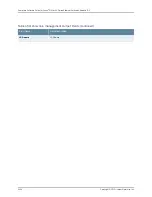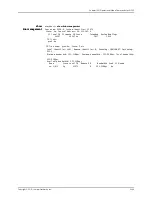
exp
forwarding-class
—(Optional) Value of the forwarding class for the MPLS ping packets.
interface
—(Optional) Specify the name of the interface protected by the manual bypass
LSP. This option is only available when you have also used the
manual-bypass
option.
logical-system (all |
logical-system-name
)
—(Optional) Perform this operation on all logical
systems or on the specified logical system.
lsp-name
—Ping an RSVP-signaled LSP using an LSP name.
manual-bypass
—(Optional) Ping manually configured bypass LSPs, used for protecting
other LSPs. For this option, you must also specify the interface protected by the
manual bypass LSP using the
interface
option.
multipoint
—(Optional) Send ping requests to each of the egress routers or switches
participating in a point-to-multipoint LSP. You can also include the
egress
option to
ping a specific egress router or switch participating in a point-to-multipoint LSP.
size
bytes
—(Optional) Size of the LSP ping request packet (
100
through
65468
bytes).
Packets are 4-byte aligned. For example, if you enter a size of 101, 102, 103, or 104,
the router or switch uses a size value of 104 bytes. If you enter a packet size that is
smaller than the minimum size, an error message is displayed reminding you of the
100-byte minimum.
source
source-address
—(Optional) IP address of the outgoing interface. This address is
sent in the IP source address field of the ping request. If this option is not specified,
the default address is usually the loopback interface.
standby
standby-path-name
—(Optional) Name of the standby path.
sweep
—(Optional) Automatically determine the size of the maximum transmission unit
(MTU).
Additional Information
If the LSP changes, the label and interface information displayed when you issued the
ping
command continues to be used. You must configure MPLS at the
[edit protocols
mpls]
hierarchy level on the remote router or switch to ping an LSP terminating there.
You must configure MPLS even if you intend to ping only LDP forwarding equivalence
classes (FECs).
In asymmetric MTU scenarios, the echo response may be dropped. For example, if the
MTU from System A to System B is 1000 bytes, the MTU from System B to System A is
500 bytes, and the ping request packet size is 1000 bytes, the echo response is dropped
because the PAD TLV is included in the echo response, making it too large.
Required Privilege
Level
network
List of Sample Output
ping mpls rsvp (Echo Reply Received) on page 3451
ping mpls rsvp (Echo Reply with Error Code) on page 3451
ping mpls rsvp detail on page 3451
ping mpls rsvp multipoint egress detail count on page 3451
ping mpls rsvp multipoint detail count on page 3451
Copyright © 2010, Juniper Networks, Inc.
3450
Complete Software Guide for Junos
®
OS for EX Series Ethernet Switches, Release 10.3
Summary of Contents for JUNOS OS 10.3 - SOFTWARE
Page 325: ...CHAPTER 17 Operational Mode Commands for System Setup 229 Copyright 2010 Juniper Networks Inc ...
Page 1323: ...CHAPTER 56 Operational Mode Commands for Interfaces 1227 Copyright 2010 Juniper Networks Inc ...
Page 2841: ...CHAPTER 86 Operational Commands for 802 1X 2745 Copyright 2010 Juniper Networks Inc ...
Page 3367: ...CHAPTER 113 Operational Mode Commands for CoS 3271 Copyright 2010 Juniper Networks Inc ...
Page 3435: ...CHAPTER 120 Operational Mode Commands for PoE 3339 Copyright 2010 Juniper Networks Inc ...
Page 3529: ...CHAPTER 126 Operational Mode Commands for MPLS 3433 Copyright 2010 Juniper Networks Inc ...






























